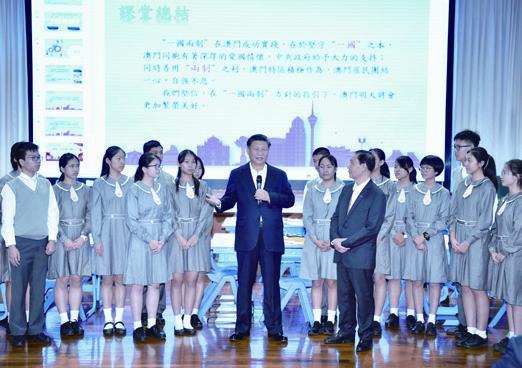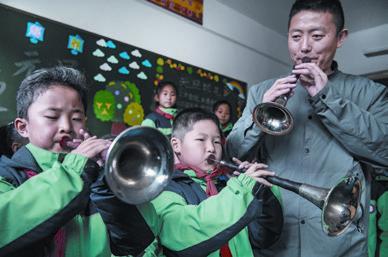A PATRIOTIC TRADITION
2019-12-27

President Xi Jinping speaks after watching a Chinese history class titled “One Country, Two Systems” and Macao at the Premier School Affiliated to Hou Kong Middle School in Macao Special Administrative Region(SAR) on December 19.
“As Chinese people, we must know the history of our Chinese nation,” he said. “The 1.4 billion Chinese people are so closely united because of the richness of the Chinese civilization and the Chinese spirit, which are the source of cultural confidence.”
The president was in Macao from December 18 to 20 for the celebrations marking the 20th anniversary of its return to the motherland, where he also expressed the hope that the Macao SAR Government will continue to boost the regions economic and social development on December 20.

All in Tune
Students play the suona, a traditional Chinese instrument, at a primary school in Yanan, Shaanxi Province in northwest China, on December 17. The school has incorporated classes on local culture such as papercutting, musical instruments and folk songs for student development.
Preparing for 2022
The recently completed Shougang Big Air slope hosted its first event ahead of the 2022 Beijing Olympic Winter Games—the 2019 Air and Style Beijing FIS World Cup—in the Chinese capital in midDecember.
Previously an old steel factory, the Shougang Industrial Park is now being transformed into the headquarters of the Beijing 2022 organizing committee, as well as the competition venue for Big Air events.
Beijing 2022 organizers say they are committed to delivering “fantastic, extraordinary and excellent”Olympic and Paralympic Winter Games, as the focus of preparations shifts from venue construction to the management and operation of competition centers.
Beijing 2022s competition and non-competition venues are located in three clusters, namely downtown Beijing, Yanqing District and Zhangjiakou in neighboring Hebei Province. By 2020, all competition venues are set to be completed.
In September, an animated giant panda named Bing Dwen Dwen and a Chinese lantern child called Shuey Rhon Rhon were unveiled as the mascots of the Olympic Winter Games and Paralympic Winter Games, respectively, followed by a global recruitment drive for volunteers on December 5. In just over four days, the number of applicants was 463,000.
In 2020, slogans as well as medal and torch design plans will be collected, and the route of the torch relay and the Games theme songs will be released.
A natural carbon dioxide refrigeration system will be used for the first time in Winter Olympic history, reducing the Games overall carbon footprint.
This system will be used at the Beijing 2022 speed skating, figure skating and short track venues as well as the ice hockey training venues.
Ethical Teaching
The Ministry of Education (MOE) and other agencies have issued a guideline to strengthen the professional ethics of teachers.
The guideline is an effort to raise teachers ethics and virtues and encourage public respect for educators and public support for education, said Ren Youqun, an official with the MOE, at a press conference on December 16.
A holistic approach and special programs will be carried out to prevent violations of professional ethics.
Teachers who violate professional ethics will face severe punishment and those who commit serious violations will be banned from teaching for life, Ren said.
He added that the guideline names professional ethics as the primary criterion regarding qualification authentication, recruitment and professional ranking of teachers.
The document also proposes measures to raise the social status and guarantee the rights and interests of educators.
The guideline was jointly issued by seven administrative departments, including the MOE, the Publicity Department of the Communist Party of China Central Committee, the Ministry of Finance and the Ministry of Human Resources and Social Security.
Vaccine Tracking
A national vaccine tracking system is expected to be completed by March 31, 2020, to enable the wholeprocess traceability of all vaccines on the market, according to a recent circular.
Jointly issued by the National Medical Products Administration(NMPA) and the National Health Commission, it specifies the responsibilities of the NMPA, provincial drug regulators, provincial health authorities and authorized manufacturers in building such a system.
The NMPA will launch a collaborative service platform. It will be connected to online systems for immunization programs and vaccine data to integrate information of vaccine production, circulation and inoculation.
The NMPA and provincial drug regulators will build the national and provincial supervision systems for vaccine traceability.
Beijing, Tianjin, Shanghai, Chongqing and Inner Mongolia Autonomous Region, along with Jiangsu and Hainan provinces are the pilots for building the system.
These areas will connect regional vaccine tracking systems with the national collaborative service platform before December 31, and begin to feed the platform information by January 31, 2020.
Global Readers
Chinas international communication programs in 2020 should support the countrys efforts to eradicate absolute poverty and complete the building of a moderately prosperous society in all respects, said Guo Weimin, Vice Minister of the State Council Information Office, at a recent conference. This aims to create a favorable environment for further reform and opening up.
Hosted by China International Publishing Group (CIPG), the annual conference seeks to promote collaboration between CIPG and local governments in presenting China to the world.
CIPG, a Beijing-based media conglomerate targeting international audiences, has many channels to communicate with readers around the world, said CIPG President Du Zhanyuan. In addition to operating media outlets such as magazines, websites and social media accounts, it hosts events attended by prominent figures, making the most of its extensive contacts worldwide.
CIPG will explore new areas of cooperation with local governments to introduce Chinas latest developments to the world, he said.
The top 10 international communication practices in 2019, selected from different parts of China, were awarded at the meeting.
Founded in 1949, CIPG publishes 34 magazines in 13 foreign languages and produces over 4,000 book titles in 40 languages every year. It has 26 overseas branches in 14 countries and regions.

Seasonal Specialty
A man ice fishes in Nuogan Lake in Inner Mongolia Autonomous Region in north China on December 18. Ice fishing has become a major tourist attraction at the frozen lake in winter when temperatures plunge to as low as -30 degrees Celsius.
BDS Progress
The deployment of the core BeiDou Navigation Satellite System (BDS) constellation was completed after the successful launch of the 52nd and 53rd BDS satellites into space on December 16.
This sets a new world record for deploying a global navigation satellite system with 1.2 satellites launched every month on average, said Yang Changfeng, chief designer of the BDS.
In the late 20th century, China started developing a navigation satellite system suited to its national conditions with a three-step strategy for building its own system. It completed the BDS-1 at the end of 2000, providing service in China.
The BDS-2 was completed at the end of 2012, providing service to the Asia-Pacific region. China started to build the BDS-3 in 2009 and launched its first BDS-3 satellite on November 5, 2017.
With the efforts of more than 100,000 researchers and engineers from some 300 research and manufacturing institutions, 28 BDS-3 satellites and two BDS-2 backup satellites were successfully sent into preset orbits in about two years, he said.
The BDS-3 project has entered the final sprint phase. To provide global service with greater performance, China plans to launch two geostationary orbit satellites by June 2020 and finish building the BDS-3 system by the end of the year.
Meanwhile, the country has started developing some key technologies for the future development of the BDS, and plans to build a comprehensive positioning, navigation and timing system by 2035.

Talent Magnet
A senior engineer from the U.S. discusses welding techniques with his coworker at Zhejiang Sany Heavy Industry Co. in Huzhou, Zhejiang Province in east China, on December 17. Huzhou has been exploring more open, diverse and market-oriented ways to attract foreign talent for better and brisker development.
Capital Market Reform
Chinas top securities regulator plans to improve governance of the capital market as part of the major tasks for 2020.
The China Securities Regulatory Commission (CSRC) said it would develop a capital market with more standardized rules, transparency, openness, vitality and resilience. Supply-side structural reform will be followed in the financial sector as specified by the annual Central Economic Work Conference in December.
Reform of ChiNext, a NASDAQstyle board of the Shenzhen Stock Exchange, will be advanced and registration on it piloted.
The CSRC will promote innovation in products and tools in the bond market, a larger supply of futures and options products, and develop private equity investment.
It will take measures to improve the quality of listed companies.
It will seek to defuse and fend off risks in key areas including stock pledges, bond defaults and private equity funds.
Banks will be supported in increasing medium- and long-term loans to the manufacturing industry, and developing credit loans and services that facilitate the roll-over of outstanding loans.
The credit quota for small and micro businesses with loans that are eligible for the preferred risk weight formula will be raised from 5 million yuan ($713,000) to 10 million yuan($1.43 million).
The average rate of government financing guarantee and re-guarantee institutions will be brought down to less than 1 percent.
“More research is needed to make breakthroughs,” Li said. “When addressing the financial risks of small and medium-sized banks, local governments must take the primary responsibilities. At the same time, such efforts must not block the lending channels for small and micro businesses.”

Light Power
A worker examines networks of photovoltaic (PV) panels in Zhangbei County in Hebei Province, north China, on December 13. The county is focusing on developing PV projects to alleviate poverty.
Wearable Market
The global wearable market saw Chinese brands increase their presence in the third quarter (Q3) of 2019 as shipments of Chinese-made wearable devices posted rapid growth, an industrial report said.
U.S. tech giant Apple, Chinese tech firm Xiaomi and the Republic of Koreas Samsung led the global wearable devices market in Q3, according to a report by global market research firm International Data Corp.
Xiaomis wearable shipments jumped to 12.4 million in Q3 from 7.4 million in 2018. Those of Chinese tech firm Huawei registered a 202.6-percent growth in the same period to 7.1 million, the highest year-on-year growth among other brands.
Wearable products mainly include earwear, wristbands and smartwatches. Earwear accounted for 48.1 percent of the total wearable market.
Cultural Industry
Chinas cultural industry posted robust revenue and profit growth in 2018, the result of the fourth national economic census showed.
By the end of 2018, the combined revenue of the cultural sector stood at 13 trillion yuan ($1.85 trillion), up 55.5 percent from 2013, according to the National Bureau of Statistics (NBS).
Profits of major cultural enterprises reached 797.14 billion yuan($113.9 billion), rising 68.8 percent from the end of 2013.
News and information services, content creation and cultural equipment manufacturing posted strong performances, with their return on assets standing at 13.3 percent, 8.3 percent and 7.5 percent, respectively.
The number of employees in the industry rose 30.8 percent from 2013 to 27.89 million with jobs in cultural services becoming the main source of employment, NBS data said.
Record Throughput
The container throughput at the Port of Ningbo-Zhoushan in Zhejiang Province in east China has exceeded the volume in 2018, handling more than 26.35 million standard containers, according to the Ningbo Zhoushan Port Co. Ltd.
The company said improved services and strengthened cooperation with global shipping giants have facilitated steady growth of the container throughput at the port.
The port has rolled out an evaluation and incentive mechanism to provide better services for shipping companies, saving cost for them and improving work efficiency.
It has deepened cooperation with international shipping companies to launch new routes along the Belt and Road. So far, the routes linking Southeast Asian countries with it have increased to 38, making it an important transfer station of cargos from the region to North America, Japan and the Republic of Korea.
The ports sea-rail transport services have also posted strong growth. The sea-rail transport links the port with other parts of China as well as countries in central and north Asia and Eastern Europe. The volume of its sea-rail transport reached 729,000 standard containers from January to November, a year-onyear increase of 33.8 percent.
The Ningbo-Zhoushan Port lies at the meeting point of the Silk Road Economic Belt and the 21st-Century Maritime Silk Road. In 2018, it registered an annual cargo throughput of over 1 billion tons, the busiest port in China.

Focal Points
A researcher checks the quality of glass fiber at a hi-tech company in Chongqing in southwest China on December 13. The area has improved the local business environment and encourages innovation to develop new industries and pursue high-quality growth.
